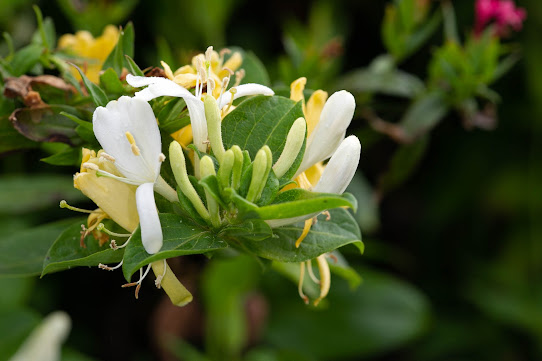A to Z challenge 2023 – L is for . . .
My
theme for this challenge is Nature in all much of her wonderful
diversity. My posts will reflect the fact that I am resident in the south of
England.
All
photographs in this post are the property of the writer.
Lonicera (honeysuckle)
Libellula depressa
The broad-bodied chaser or darter is one of the commonest UK dragonflies, with a wingspan of about 70mm (just over 2¾ inches) and is not one of the most attractive. The male has a pruinose blue abdomen. Now, pruinose is an adjective unfamiliar to me and I rather liked the sound of it. Simply expressed, which suits me, as I’m a simple soul, it means ‘frosted –looking’. I have seen the colour described as 'powder blue', which makes it sound quite delicate.
However, the one in our photographs is a female, described as ‘golden or greeny-brown’.
Broad-bodied chasers are on the wing from May to July and eat midges and mosquitoes, so are a welcome visitor near bodies of still or slow-moving water.
Lily beetle
This little beetle's scientific name is Lilioceris lilii - isn't that a lovely name? It rolls off the tongue.
Lily beetles are attractive scarlet pests that attack lilies (surprisingly!) and fritillaries and need to be removed.Lily beetles doing what comes naturallyI don’t like squashing them so throw them in the pond for the fish. It’s probably far crueller to drown them!











My word you attract some interesting comments. Meanwhile we love your lonicera - ours has gone a bit out of control (F's fault for planting it in a silly place). We tried growing one that has edible fruit but were unsuccessful (big fail there). xxx Mr T
ReplyDeleteI'll have to make sure my passport is in order so that I can follow up these tempting offers!
DeleteOur honeysuckles and jasmines - well, everything really, are out of control and need some serious hacking back.
Our philosophy, if we had one, would be, plant first then consider if the plants are in the right place. I blame Monty Don . . .
I love the fragrance of honeysuckle, but it definitely has to be pruned! My garden can easily get overrun by the traveling vine if it isn’t trimmed into place. Great photos!
ReplyDeleteSee my comment above!
ReplyDeleteThe perfume of honeysuckle is just heavenly. We have way too much invasive Japanese honeysuckle bushes all over the country. It is overpowering and replacing our native bushes. The beautiful vine you have can be easily controlled to stay in the garden.
ReplyDeleteOur have not escaped the garden and I don't think they will. Too many things do escape and become countryside thugs.
DeleteFlower without a fragrance should quite rare, is it not? We are so habituated to think that all flowers have some fragrance.
ReplyDeleteI think so. Some have scents that are less than lovely!
ReplyDeleteMaybe I should plant some honeysuckle in my out of control full of invasives yard. Maybe it would cover some of them up at the least. I love the smell.
ReplyDeletehttps://findingeliza.com/
It's worth a try:-)
DeleteYou had me at 'honeysuckle'.
ReplyDeleteCheers! Gail.
Ah, I love honeysuckle :-)
DeleteThere's a lot going on in a honeysuckle blossom - I've never seen one up close before. In fact, I may have never seen one at all here. Another thing to Google :) Dragonflies are amazing creatures, aren't they - such delicate wings to hold up such a sturdy body.
ReplyDeleteLooking closely at any flower is amazing. As for dragonflies, it's another world.
ReplyDeleteYour photos are amazing Janice. Your photography is wonderful. I have honeysuckle climbing over a trellis but it doesn't flower a great deal. The common type I have can be very invasive so I am always cutting it back. Happy Weekend to you Janice. xx
ReplyDeleteThank you, Julie. Although I do take lots of photographs, it's the photographer-in-chief who really understands what he's doing.
DeleteI suppose the fish quickly find the lily beetles. You've kindled a childhood memory for me, of licking the stamen of a honeysuckle flower for the nectar. Why did we do that?
ReplyDeleteI don't think I ever did that - chewing grass stems, yes . . .
DeleteHeady scent - so beautiful ... love your choices - poor beetles, lucky fish! ... cheers Hilary
ReplyDeleteI can never have too much honeysuckle, Hilary.
ReplyDeleteI love honeysuckle and dragonflies, not so much those pesky lily beetles! And thank you for introducing me to that lovely adjective, pruinose! xxx
ReplyDeleteNow waiting for opportunities to use 'pruinose' in conversation . . . ha ha ha x
DeleteThe honeysuckle and dragonflies are so pretty!
ReplyDeleteRonel visiting for L:
My Languishing TBR: L
Let it Go: Lethe
Thank you, Ronel.
ReplyDelete